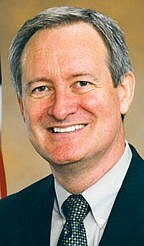The Idaho National Laboratory's Nuclear Legacy
SEN. MIKE CRAPO/Contributing Writer | Bonners Ferry Herald | UPDATED 2 years, 2 months AGO
I was born just a few miles away from the National Reactor Testing Station the same year it proved we could use atomic power to generate electricity. In 1951, Walter Zinn and his team were able to power four light bulbs using a nuclear reactor. Today, the Idaho National Laboratory (INL) continues to lead the way in driving innovation across the industry.
This includes finding ways to create accident-tolerant fuels and develop small modular reactors and other advanced nuclear concepts. Nuclear energy is good for jobs, good for the economy, good for our air, and it is a great source of base-load clean energy. It must be a part of any conversation of an all-of-the-above approach to our nation’s energy portfolio.
Since coming to Congress, I have worked with my colleagues to advance nuclear energy research and production across our country. Over the past few Congresses, I was successful in navigating the passage of the Nuclear Energy Innovation Capabilities Act (NEICA) and the Nuclear Energy Innovation and Modernization Act (NEIMA). Both of these bills served as significant steps toward eliminating some financial and technological barriers standing in the way of nuclear innovation. These efforts have directly benefited the INL, especially in the lab’s successful efforts to host the Versatile Test Reactor, which will allow testing of nuclear materials 10 times faster than what is currently capable today.
Building off the success of NEICA and NEIMA, I joined my colleagues in introducing the American Nuclear Infrastructure Act (ANIA). ANIA would support the work being done at INL by:
• Increasing the efficiency and predictability of permitting processes for advanced nuclear;
• Furthering the development of advanced nuclear fuels; and
• Enabling preparation for advanced reactor demos at U.S. Department of Energy (DOE) sites like INL.
Additionally, ANIA would advance U.S. nuclear competitiveness through:
• Greater collaboration with U.S. allies;
• Strengthening our current aging nuclear fleet; and
• Increasing our energy security by reducing our reliance on China and Russia for nuclear fuel.
• Senate negotiations continue on this important legislation that I am hopeful will see movement.
The work that takes place at the lab shows policy-makers what is achievable when Congress prioritizes innovation. It is an honor to be a part of and serve this community of extraordinarily intelligent and creative individuals who have made the lab what it is today. I relish the opportunity to promote the work being done in Idaho and tell others in Washington, D.C., of nuclear power’s positive potential. And, I look forward to continuing to advocate for nuclear energy, as the INL is solidly rooted as a cornerstone of the eastern Idaho community. Just as our world's first electricity-generating nuclear power plants lit those first bulbs back in 1951, the INL is illuminating the future of energy in this country.


